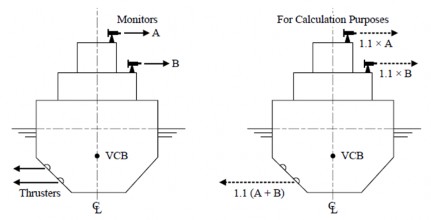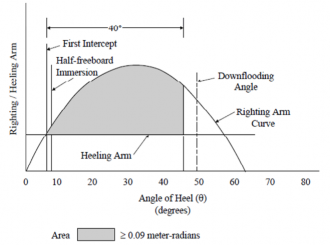

< Previous | Contents | Next >
Section 2 Stability
201. General
1. Intact stability are to be in accordance with this section in addition to Ch 3, Sec 1. However, for ships specifically approved by the Society, these requirements may be waived.
2. Stability to be considered especially to the ships that have specially designated operations.
202. Calculation on stability
In applying the requirements in Ch 3, Sec 1, the heeling lever resulting from designated oper- ations is to be considered the one most unfavorable for stability.
203. Intact Stability Requirements for Fire Fighting Operations
1. General
The intact stability of each vessel receiving a fire fighting notation is to be evaluated for the load-
ing conditions indicated in Ch 3, 102. for compliance with the intact the results are to be submitted for review.
2. Intact Stability Criteria
(1) Fire Fighting Operations
Each vessel is to have adequate stability for all loading conditions, itors operating at maximum output multiplied by a factor of 1.1
stability criteria in 2., and
with all fire fighting mon- in the direction most un-
favorable to the stability of the vessel. The thruster(s) are to be considered operating at the
power needed to counter-act that force. For the calculation purposes, the total thruster force should be vertically located at the location of the lowest available thruster (see Fig. 8.1).

Fig. 8.1 Heeling Moments - Fire Fighting Operations
The heeling moment due to the operation of all fire fighting monitors and thrusters is to be converted to a heeling arm, and superimposed on the righting arm curve of each loading condition. The first intercept must occur before half of the freeboard is submerged. The area of the residual stability (area between the righting arm and heeling arm curves beyond the angle of the first intercept) up to an angle of heel 40° beyond the angle of the first intercept; or the an- gle of downflooding if this angle is less than 40° beyond the angle of the first intercept, should not be less than 0.09 meter-radians (see Fig. 8.2).
42 Guidance for Offshore Support Vessels 2015
![]()

Fig. 8.2 Righting Arm and Heeling Arm Curves
3. Stability Guidance for the Master
The Master of the vessel should receive information in the Trim and Stability Booklet regarding cargo limitations, list of protected flooding openings that need to be kept closed, wind and/or wave restrictions, etc., necessary to ensure that the stability is in compliance with the criteria given in 2..
If any loading condition requires water ballast for compliance with the criteria in 2., the quantity and disposition should be stated in the guidance to the Master.